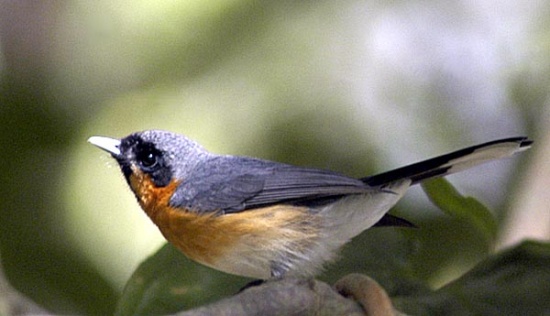| This article is incomplete. This article is missing one or more sections. You can help the BirdForum Opus by expanding it. |

- Symposiachrus trivirgatus
Monarcha trivirgatus
Includes Moluccan Monarch
Identification
Blue-grey upperparts, black face mask that extends across both eyes, rufous breast, white underparts, black tail with white outer tips. Immature birds lack the black face and have a grey throat.
Distribution
Coastal north-eastern and eastern Australia, Papua New Guinea, the Moluccas and Timor.
Taxonomy
Formerly placed in genus Monarcha. Moluccan subspecies bimaculatus, diadematus and nigrimentum may be split as "Moluccan Spectacled Monarch", S. bimaculatus [2] based on plumage differences and molecular evidence.
Subspecies
There are 9 subspecies [1], many of which may represent different species [2]:
- S. t. bimaculatus: "Moluccan Spectacled Monarch". Morotai, Halmahera and Bacan (Moluccas)
- S. t. diadematus: "Moluccan Spectacled Monarch". Obi and Bisa (Moluccas)
- S. t. nigrimentum: "Moluccan Spectacled Monarch". Seram and Ambon (Moluccas)
- S. t. wellsi: Seram Laut and Watubela Islands
- S. t. trivirgatus: Lesser Sundas
- S. t. albiventris: northeastern Australia: Torres Straits islands, and coastal northeastern Queensland
- S. t. melanopterus: Southeastern Islands of southeastern New Guinea
- S. t. melanorrhous: East Queensland, Australia
- S. t. gouldii: breeds eastern Australia; wintering to southern New Guinea and Torres Strait Islands
Habitat
Thick understorey in rainforests, wet gullies and waterside vegetation, as well as mangroves.
Behaviour
The diet includes insects.
It builds a small cup nest of fine bark, plant fibres, moss and spider web in a tree fork or in hanging vines, often near water.
References
- Clements, J. F., T. S. Schulenberg, M. J. Iliff, T. A. Fredericks, J. A. Gerbracht, D. Lepage, S. M. Billerman, B. L. Sullivan, and C. L. Wood. 2022. The eBird/Clements checklist of Birds of the World: v2022. Downloaded from https://www.birds.cornell.edu/clementschecklist/download/
- Eaton, J.A.. van Balen, B. Brickle, N.W., B Rheindk F.E. (2021). Birds of the Indonesian Archipelago, Greater Sundas and Wallacea. Lynx Edicions. Barcelona. Second Edition
External Links
GSearch checked for 2020 platform.1



